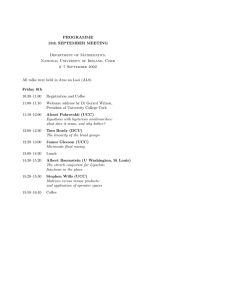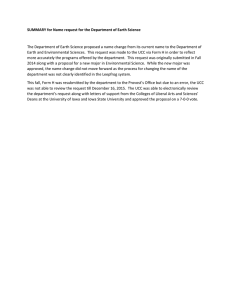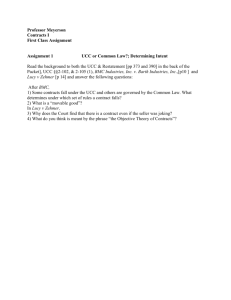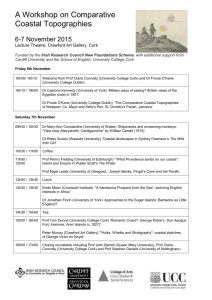Reports of Sponsored Meetings Algebraic Geometry Conference 2012 MIC Limerick
advertisement
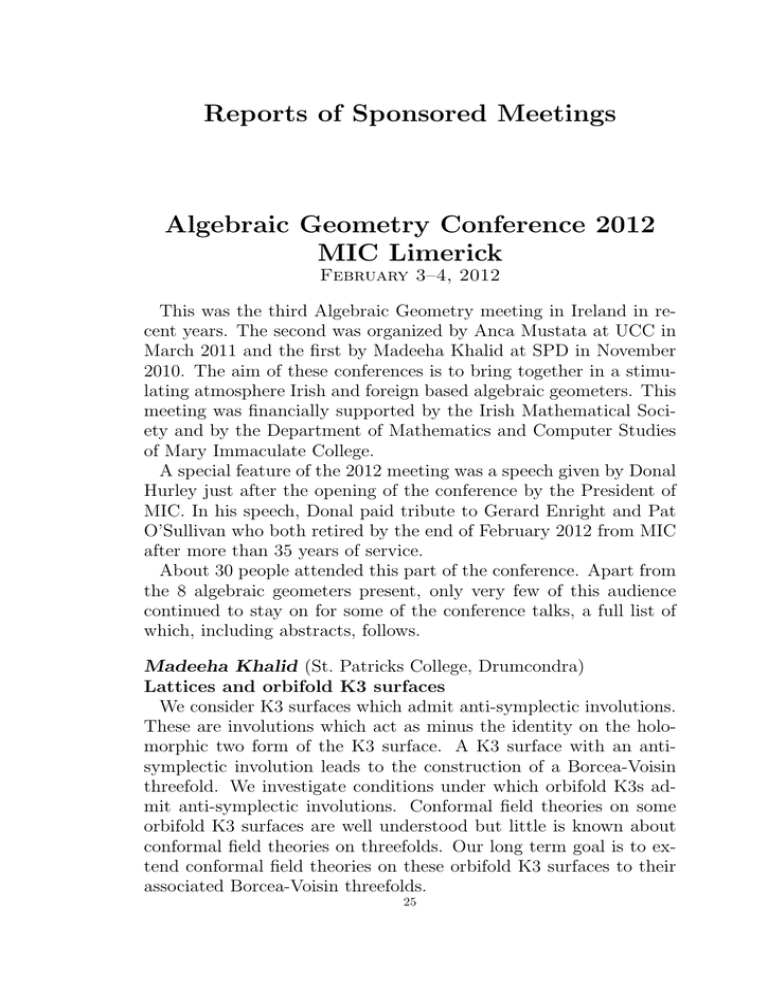
Reports of Sponsored Meetings Algebraic Geometry Conference 2012 MIC Limerick February 3–4, 2012 This was the third Algebraic Geometry meeting in Ireland in recent years. The second was organized by Anca Mustata at UCC in March 2011 and the first by Madeeha Khalid at SPD in November 2010. The aim of these conferences is to bring together in a stimulating atmosphere Irish and foreign based algebraic geometers. This meeting was financially supported by the Irish Mathematical Society and by the Department of Mathematics and Computer Studies of Mary Immaculate College. A special feature of the 2012 meeting was a speech given by Donal Hurley just after the opening of the conference by the President of MIC. In his speech, Donal paid tribute to Gerard Enright and Pat O’Sullivan who both retired by the end of February 2012 from MIC after more than 35 years of service. About 30 people attended this part of the conference. Apart from the 8 algebraic geometers present, only very few of this audience continued to stay on for some of the conference talks, a full list of which, including abstracts, follows. Madeeha Khalid (St. Patricks College, Drumcondra) Lattices and orbifold K3 surfaces We consider K3 surfaces which admit anti-symplectic involutions. These are involutions which act as minus the identity on the holomorphic two form of the K3 surface. A K3 surface with an antisymplectic involution leads to the construction of a Borcea-Voisin threefold. We investigate conditions under which orbifold K3s admit anti-symplectic involutions. Conformal field theories on some orbifold K3 surfaces are well understood but little is known about conformal field theories on threefolds. Our long term goal is to extend conformal field theories on these orbifold K3 surfaces to their associated Borcea-Voisin threefolds. 25 26 Manfred Lehn (Johannes Gutenberg Univ. Mainz, Germany) The theorem of Grothendieck-Brieskorn-Slodowy and symplectic hypersurfaces Both, simple complex Lie algebras and Kleinian surface singularities, are classified by Coxeter-Dynkin graphs. In the first case the graph describes the root system of the Lie algebra, in the second case the intersection behaviour of the exceptional curves in a minimal resolution of the singularity. A simple connection between these apparently quite different topics was conjectured by Grothendieck and proved by Brieskorn for ADE-graphs and by Slodowy for BCFGgraphs. I shall illustrate this classical result with explicit examples and show how the theorem can be naturally generalised in the holomorphically symplectic context. This also leads to new four- and sixdimensional symplectic hypersurfaces, which could be considered as higher dimensional analogues of the classical Kleinian singularities. Ana Cristina López Martı́n (Univ. of Salamanca, Spain) The group of relative Fourier-Mukai transforms of some fibrations Since its introduction by Mukai, the theory of integral functors and Fourier-Mukai transforms has been an important tool in the study of the geometry of varieties and moduli spaces. Working with a fibered scheme over a base T it is quite natural to look at the group of T -linear autoequivalences. The description of this group seems a hard problem. We will restrict ourselves to the subgroup given by relative Fourier-Mukai transforms. In this talk, I will explain how for a projective fibration the knowledge of the structure of the group of autoequivalences of its fibres and the properties of relative integral functors provide a machinery to study that subgroup. I will work out the case of a Weierstrass fibration and report about the results for abelian schemes and Fano or anti-Fano fibrations. This is a joint work with D. Sánchez Gómez and C. Tejero Prieto. Andrei Mustaţă (University College Cork) On the Intersection Theory of Chow Quotients GIT quotients are often use in the construction of moduli spaces. Important invariants for the moduli spaces can be constructed via the intersection ring of the GIT quotients. However a GIT quotient is depending on the choice of a linearized line bundle, so in general is not unique. In the case of quotients by (C∗ )n we will show that 27 there exists a natural ring containing the information of all the GIT quotients and we interpret this ring in terms of the intersection theory of a geometrical object: the inverse limit of the GIT quotients. Moreover this inverse limit has a modular interpretation. Vahid Yazdanpanah (University College Cork) Inverse limit of GIT quotients of Grassmannians by a torus The inverse limit of GIT quotients of a grassmannian variety by a torus acting on it is the closure of a moduli space of very stable pairs of Hacking et al. In particular for G(2, n + 1) this moduli space is M 0,n . We can study the intersection theory of such a moduli space based on the intersection theory of the GIT quotients appearing in this context. In this project we have studied the GIT quotients of G(3, 6) by a maximal torus of SL6 . These quotients are nice toric varieties and the morphisms between them can be described very concretely. Their inverse limit, M , is the moduli space of compactification of arrangements of 6 lines in P2 . In general, for G(m, n) when n > 2, this moduli space has a number of distinct components of different dimensions. A natural class of suitable dimension, that plays the role of the fundamental class, is necessary for a relevant intersection theory on M . Report by Bernd Kreussler, Mary Immaculate College, Limerick. bernd.kreussler@mic.ul.ie Mini-symposium in memory of Professor Frank Hodnett UL June 8, 2012 On June 8th 2012, the University of Limerick hosted a one-day mini-symposium in memory of Prof. Frank Hodnett, RIP, the founding head of the Department of Mathematics and Statistics (UL), who passed away on July 5th, 2011, RIP. Prof. Don Barry (UL President) welcomed Frank’s family, including his wife Diane and children David and Nicola, visitors from the UK and many of his colleagues from around the country. Dr. Ed Walsh also extended a welcome and spoke of Frank’s arrival at NIHE in the early 1970s. 28 The symposium was a mixture of mathematical talks (mostly of the survey variety) and recollections of Frank’s life and times. The speakers included Prof. Derek Ingham (Leeds) and Prof. Sean McKee (Strathclyde), Prof. Finbarr Holand (UCC), Prof. Matthew Mc Carthy (NUIG), Prof. Michael Wallace, Prof. James Gleeson and Gordon Lessells (UL). At the end, Frank’s son David expressed the appreciation of the Hodnett family. There was a reception immediately afterwards hosted by Frank’s cousin, Prof. Kieran Hodnett (Dean, Faculty of Science and Engineering, UL). Later that evening, many of the participants met for dinner in the Carlton Castletroy Park Hotel. The mini-symposium was funded by the Faculty of Science and Engineering (UL), the Department of Mathematics and Statistics (UL) and by the Irish Mathematical Society. Report compiled by Eugene Gath, UL. eugene.gath@ul.ie Tenth Irish Geometry Conference UCC June 13–14, 2012 The 10th Irish Geometry Conference 2012 took place at University College Cork on June 13 and 14. The talks were: Stephen Coughlan (University of Massachusetts Amherst), Explicit models for elliptic surfaces. Detta Dickinson (National University of Ireland Maynooth), When is the root of an integer polynomial real? Yunfeng Jiang (Imperial College), Orbifold quantum cohomology under flops. Stephen Buckley (National University of Ireland Maynooth), An overview of Rough CAT(0) spaces. Bernd Kreussler (Mary Immaculate College, University of Limerick), On fine analytic moduli spaces of sheaves. Masha Vlasenko (Trinity College Dublin), Geometricity Problem for Differential Equations. 29 Thomas Murphy (Universit Libre de Bruxelles), Stability of KahlerRicci solitons. Report compiled by Ben McKay, UCC. b.mckay@ucc.ie Nonlinear Dynamics Conference in Honour of Alexei Pokrovskii UCC September 5–9, 2012 This meeting continued the tradition of the series of multidisciplinary conferences, which the late Professor Pokrovskii organised at University College Cork since 2002. The conference series, which acquired the acronym MURPHYS (International Workshops on Multi-Rate Processes & Hysteresis) from 2006, is unique in its effort to bring together renowned experts in multi-scale problems and experts in hysteresis modelling with diverse research backgrounds: applied mathematicians, physicists, engineers, biologists. Scientists of the highest international standard contributed to the Workshop this year. Topics of this conference reflected the diversity of Prof. Pokrovskiis contribution to science and included nonlinear dynamical systems, systems with hysteresis, chaos and complexity, stochastic systems, control theory, singularly perturbed systems and mathematical modelling. The range of applications presented at the Workshop included engineering, optoelectronics and laser dynamics, plasma physics, chemical and pharmacokinetics, combustion, hydrology, hydrodynamics, ecoepidemiology, financial mathematics and economics. The diversity of the problems presented combined with the critical mass of commonality in the methodologies used to approach them underpinned the coherence of the programme and made the Workshop most interesting and stimulating for all the participants. The free exchange of ideas and knowledge was of particular benefit to our postgraduate students, many of whom gave presentations on their own research. The Conference programme is available at the conference home page http://www.ucc.ie/en/euclid/NonlinearDynamicsConferenceinMemoryofAlexeiPokrovskii/ 30 Selected conference papers will be published in the special volume of the journal Discrete and Continuous Dynamical Systems B dedicated to Prof. Pokrovskii. The special issue will appear next year. Most of the conference presentations and other conference materials are available at the conference web page above, which will be maintained. There is a strong intention to continue the MURPHYS conference series with the support of the international community. Next year, the conference will be organised in Romania, then in Berlin, and we plan to have the conference back in Cork after that. The 5-day conference programme consisted of 45 presentations. There were 60 participants, 35 from Ireland and 25 from abroad. There was a high level of public attendance and participation, mostly from the UCC community, but also including attendees from other universities and overseas 15-20 people, apart from the participants, attended various conference sessions and contributed to the discussion. Academic participants from UCC, CIT, Tyndall National Institute, DCU and University of Limerick contributed to the conference programme. The overseas invited speakers were: Brian Appelbe (Imperial College London, UK) Rod Cross (University of Strathclyde, UK) Gary Friedman (Drexel University, USA) Ondrej Hovorka (University of York, UK) Ram Iyer (Texas Tech University, USA) Amalia Ivanyi (University of Pecs, Hungary) Leonid Kalachev (University of Montana, Missoula, USA) Marina Kleptsyna (Universit du Maine, France) Jana Kopfova (University of Opava, Czech Republic) Petra Kordulova (University of Opava, Czech Republic) Victor Kozyakin (Institute for Information Transmission Problems, Moscow, Russia) Alexander Krasnoselskii (Institute for Information Transmission Problems, Russia) Pavel Krejci (Institute of Mathematics, Prague, Czech Republic) Petr Kucera (Institute of Mathematics, Prague, Czech Republic) Sergei Kuksin (Heriot-Watt University, Edinburgh, UK and l’Ecole polytechnique, Palaiseau, France) Hugh McNamara (University of Oxford, UK) Robert E. OMalley (University of Washington, USA) Suzanne ORegan (University of Georgia, USA) Alexey Pokrovskiy Jr. (London School of Economics, UK) Nikola Popovic (University of Edinburgh, UK) Vincenzo Recupero (Politecnico di Torino, Italy) Sergei Sazhin (University of Brighton, UK) Elena Shchepakina (Samara State Aerospace 31 University, Russia) Victor Shrira (Keele University, UK) Vladimir Sobolev (Samara State Aerospace University, Russia) Pawe Wilczyski (Institute of Mathematics, Jagiellonian University, Poland) Eight students were awarded prizes for the best presentation in various categories, including the best student presentation in applied mathematics, engineering, mathematical biology, mathematical ecology and others: Mr Edward OGrady (University College Cork) Mr James Grannell (University College Cork) Ms Tanya Habruseva (Cork Institute of Technology) Mr Stephen McCarthy (University College Cork) Mr Raymond O’Connor (University College Cork) Ms Catriona de Paor (University College Cork) Mr Alexey Pokrovsky (London School of Economics) Mr Gearoid Ryan (University College Cork) The conference was attended by Open Innovation Partners, a company based in Cork (Mr Diarmuid Cahalane) and J. P. Morgan, a leading financial services provider (Dr Andrew Zhezherun and Dr Oleg Rasskazov from the Analytic Dept at J. P. Morgan London Office). The colleagues from industry actively engaged in discussions with the academic community at the conference sessions. In particular, they offered a few interesting problems in the area of financial mathematics. Participation from industry was very stimulating for the researchers from academia. The relationship of the UCC School of Mathematical Sciences with the Analytic Department at J. P. Morgan London Office is of strategic importance for the ongoing research in modelling financial markets and macroeconomic modelling conducted in the School. Dr Zhezherun and Dr Rasskazov did their PhD in UCC. This relationship also benefits our Financial Mathematics Degree Programme opening job opportunities for our graduates as well as possibilities of work placement and internship. Future developments in these directions were discussed at the conference. The conference was also supported by SFI, Open Innovation Partners, and the IMS. Report compiled by Dmitri Rachinskii, UCC. d.rachinskii@ucc.ie
